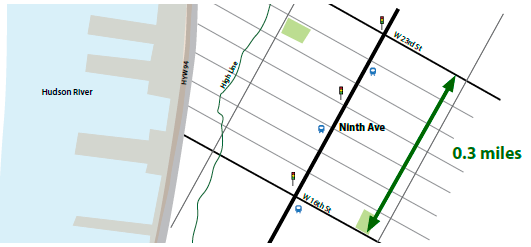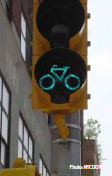ROAD DIET ON ONE-WAY STREET DESIGNED FOR ALL USERS
| Objective | Features | Results |
|---|---|---|
|
|
|

BACKGROUND
In 2007, New York City Department of Transportation (NYCDOT) implemented a Road Diet that completely redesigned Ninth Avenue. Prior to the reconfiguration, Ninth Avenue, a one-way street, consisted of four through lanes with parking on both sides, but no bicycle facilities and few pedestrian safety features. The redesign included three through lanes, a separated bicycle path located between the parking lane and sidewalk, and pedestrian refuge islands.

 Bicycle lane, parking, and pedestrian refuge island on Ninth Avenue. |
Turning onto Ninth Avenue and heading down the bike lane was a spectacular experience – I immediately felt comfortable and safe, and my stress level decreased by orders of magnitude.1 |
PLANNING AND DESIGN
During the planning and design process, NYCDOT communicated openly to determine potential issues and address concerns from stakeholders and community representatives. The design considered the needs of all street users including bicyclists, pedestrians, motorists, bus riders, delivery persons, and emergency response personnel. Design considerations included the following:

- DOT staff analyzed traffic volumes to ensure excess congestion would not occur with one less through lane.
- Designers placed the bicycle path between the parking lane and the sidewalk, creating a safe and comfortable atmosphere for bicyclists. New bicycle signals provided traffic control on the bicycle path.
- At intersections where vehicle left-turns cross over the bicycle lane, designers added left turn bays adjacent to the bicycle lane and provided protected turn phases to completely separate the conflicting through cyclist and left-turning vehicle movements.
- The project included pedestrian refuge islands, narrowing the crossing distance of Ninth Avenue for pedestrians by almost 30 feet. The design of the islands also accommodated an opening of 11 feet from the curb to allow for ease of curbside cleaning for the city's mechanical sweepers.
- Special parking locations were incorporated along the corridor such as commercial loading zones that utilize multi-space parking meters and parking spaces in high-use areas just for taxi drivers.
RESULTS
"The innovative design [on Ninth Avenue] has created a safe, comfortable, and unique street that will be the foundation for the future expansion of our bicycle network in heavily trafficked areas of our city", says NYCDOT. "This groundbreaking design is one that can be utilized by other jurisdictions to promote bicycling while providing safe streets for all users."2
In 2008, the Institute of Transportation Engineers (ITE) honored the success and creativity of NYCDOT's Road Diet project on Ninth Avenue by awarding it the Transportation Planning Council Best Program Award. The project's success was confirmed further in 2012 when NYCDOT reported that Ninth Avenue experienced a 58 percent decrease in injuries to all street users.3
1 Nick Grossman,"Ninth Avenue Gets a Physically Separated Bike Lane" Streetfilms Blog, October 3, 2007. Accessed March 19, 2015. Available at: http://www.streetfilms.org/ninth-avenue-gets-a-physically-separated-bike-lane/
2 R. Russo, R. Wade, J. Benson, C. Lucas, "Ninth Avenue Bicycle Path and Complete Street," page 6. Accessed March 19, 2015. Available at: http://www.nyc.gov/html/dot/downloads/pdf/rr_ite_08_9thave.PDF
3 New York City DOT, "Measuring the Street: New Metrics for 21st Century Streets" page 4. Accessed March 19, 2015. Available at: http://www.nyc.gov/html/dot/downloads/pdf/2012-10-measuring-the-street.pdf
